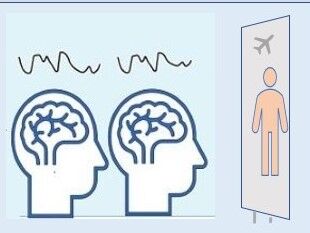Default Mode Network
How Videos Recruit a Brain Network to Share Stories
The Default Mode Network can sync between people watching the same events.
Posted February 16, 2021
If you׳re immersed in more video dramas than usual while stuck at home, you may be switching on a brain pathway that helps stories make sense to several viewers of the same drama. That’s one interpretation of a new theory in Nature Neuroscience Reviews for January 21 with the intriguing title “The Default Mode Network: Where the Idiosyncratic Self Meets the Social World.”
This network, discovered by Dr. Morris Raichle by brain imaging of volunteers using functional magnetic resonance imaging (fMRI) in 2001, was called the Default Mode Network or DMN because it turns on when you’re not focused on an external task like driving a car, ordering online, or making a pizza. The way a region in the DMN synchronizes together with that of another person might be compared with how a violin and cello can follow a score to play the same melody. Only in this case, it would be two people responding to the same story. The corresponding brain centers in their DMN might react in a similar way, correlated or coupled with each other, but modified by individual memories and biases.
Curiously, research has credited the DMN with multiple functions like daydreaming, resting, reminiscing, planning, and even depressive rumination. The DMN connects separate brain areas from the very front and center (in the prefrontal lobes) to the sides (the junction between parietal and temporal lobes), and to a lesser-known region (the posterior cingulate gyrus) further back in the midline.

Research reviewed by Yeshurun, Nguyen, and Hasson in Nature Neuroscience Reviews (2021) reviewed the time-course of brain activity in specific DMN regions in volunteers, as measured in functional MRI scans by blood-oxygen-level-dependent (BOLD) signals fluctuating up and down with neural activity in those regions. In several studies, the pattern of these waves was correlated when two people witnessed the same story, whether delivered by video or by speech, but was also influenced by the experiences of each person seeing or hearing the story. These wave reflect neural activity, but differ from the EEG or other electrical signals from the brain.
Furthermore, the correlation of brain activity in two people given the same story only appeared when they were paying attention and the story made sense. Nonsense words or images did not have a similar effect. The shared information interacted with each individual's own information remembered over the past few seconds and longer.
The authors proposed that:
The integration of extrinsic and intrinsic information over long timescales provides a space for negotiating a shared neural code, which is necessary for establishing shared meaning, shared communication tools, shared narratives and, above all, shared communities and social networks (Yeshurun, Nguyen, and Hasson, 2021).
As an example, in one study the pattern of people's brain responses was influenced by whether or not they had seen a previous episode of "The Twilight Zone" or “Game of Thrones.” But because of this network’s similarities in different people observing the same story, the authors pointed to its important role in shared experiences, contributing to what they called the “social world.”
So an extension of these studies suggests that the correlations seen in response to filmed or narrated information might also apply to scenarios from real life.
Copyright (2021) by Robert A. Lavine, PhD
References
Yeshurun, Y., Nguyen, M. & Hasson, U. (2021). The default mode network: where the idiosyncratic self meets the shared social world. Nature Reviews Neuroscience. https://doi.org/10.1038/s41583-020-00420-w.
Raichle, M.E. and others (2001). A default mode of brain function. Proc. Nat. Acad. Sci. 98:676-682.


